娜塔莉‧贝纳利:我所看到的中国
发布时间:2024年03月18日 | 来源:理论中国2024-03-13 | 字体放大 | 字体缩小
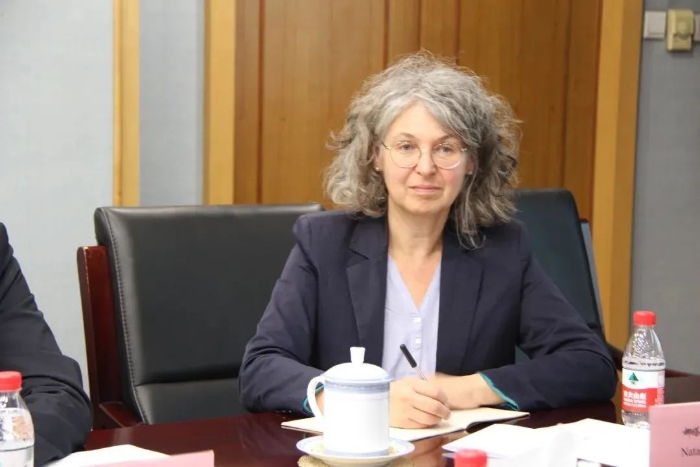
2023年10月8日,娜塔莉‧贝纳利在中央党史和文献研究院参加座谈交流。
编者按:娜塔莉‧贝纳利(Natalie Benelli)博士是瑞士“新媒体”组织联合创始人、《新北方》杂志主编,同时也担任纽约“女性媒体”组织驻欧洲记者。2023年10月,贝纳利博士随瑞士友好人士考察团访华,期间到访中共中央党史和文献研究院,就中国共产党和中国的发展经验,特别是中国式现代化等问题进行座谈交流,“理论中国”公众号曾作专题报道。中国之行后,贝纳利博士基于亲身经历和第一手资料,以“我所看到的中国”为题撰文,介绍她在中国的所见所闻,发表在“女性媒体”组织《集体事业》杂志,并专门将文章寄送给“理论中国”通讯员。在文章中,贝纳利博士坦言“百闻不如一见”,她所看到的现代化和快速发展的中国与西方一些媒体的报道“明显不同”。贝纳利博士以外国人视角描述中国经济社会文化发展,具有一定的典型性,经作者同意,“理论中国”特将其文章编译如下,以飨读者。
我所看到的中国
娜塔莉‧贝纳利(博士)
2023年10月,我来到中国,首先访问了首都北京,随后访问了上海、贵阳以及新疆维吾尔自治区的乌鲁木齐和喀什。我看到了一个现代化、进步和快速发展的国家,它在扶贫、环境保护以及欠发达地区的经济和社会发展方面投入了大量资金。这与西方主流媒体的报道明显不同。
中国14亿人口中的大多数居住在发达的东部地区,像北京和上海这样的城市拥有 2,000 万至 3,000 万人口。与我访问过的世界其他地区的城市不同,北京和上海并不混乱或嘈杂。这是因为街上电动车和自行车的比例很高。此外,北京和上海的街道两旁都有大小不一的花坛、灌木丛和树木,使城市变成了绿地,大大改善了空气质量。在过去十年中,全国有55.03亿人次义务参加植树,累计植树216.86亿株。中国政府还大力投资风能、水能和太阳能等非化石可再生能源。
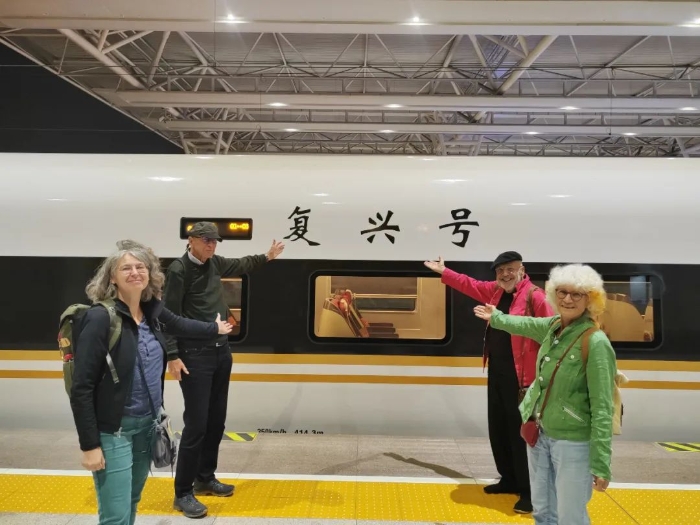
通过扩大高铁网络,中国提高了人员和货物的流动效率。以时速 350公里计算,乘坐高铁从北京到上海只需不到4.5小时。中国的基础设施发展计划也惠及中国的欠发达地区,例如贵州省,该省拥有世界上最高的桥梁和最大的射电望远镜。
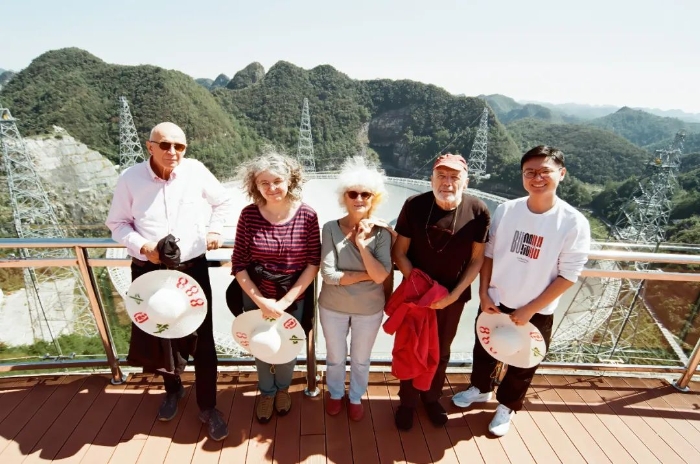
▲考察团一行在贵州参观球面射电望远镜(中国天眼)
贵州省92.5%的面积被丘陵和山地覆盖,中国政府根据贵州省的自然条件,大力投资建设铁路、高速公路、公路和桥梁,以开发贵州省的经济潜力。除了烟草种植和白酒生产等传统产业外,贵州省还利用其天然磷矿资源生产电动汽车电池。虽然贵州仍是中国相对欠发达的省份之一,但其经济增长率已跻身全国前三名。
在北京,我和同行者有机会和中华全国妇女联合会联络部的三位代表交流。中华全国妇女联合会是一个全国性机构,县以上妇联团体会员有将近9,000个,致力于中国的男女平等。妇联通过向低收入地区的女童和青年妇女提供奖学金,培训妇女创办自己的企业来消除贫困,从而促进女性领导力的发展。妇联还与相关部委合作,为农村地区65岁以上的妇女提供免费体检。2003年启动的“母亲健康快车”项目,为偏远地区的妇女儿童提供医疗服务,受益人次超过8,000万人。

▲考察团一行在新疆
中国通往欧洲的大门
我此行的最后一站是位于中国西北部的新疆维吾尔自治区。新疆与八个邻国接壤,边境线长达5,700多公里,历来是中国通往中亚和欧洲的门户。新疆是古代丝绸之路的重要交通枢纽,也是当今“一带一路 ”倡议(BRI)的关键所在。
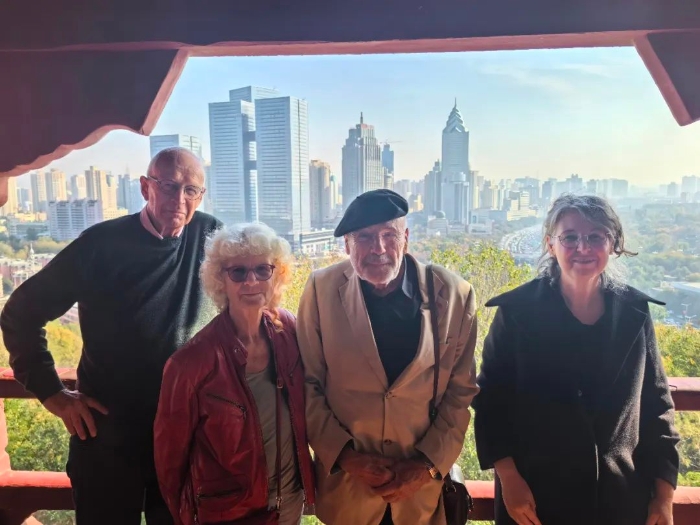
“一带一路 ”倡议是中国自2013年以来与非洲、亚洲、拉丁美洲和欧洲的150多个国家合作建设的洲际基础设施网络,包括公路、铁路、港口和机场。与国际货币基金组织和世界银行的贷款不同,“一带一路 ”倡议的基础设施项目并不与削减教育、医疗保健和社会服务方面的公共开支挂钩,而是促进相关国家的经济发展和自主。
新疆占中国国土面积的六分之一。新疆是许多少数民族的聚居地,具有文化多样性。新疆2,500多万居民中有45%是维吾尔族,其他少数民族包括哈萨克族和回族等。
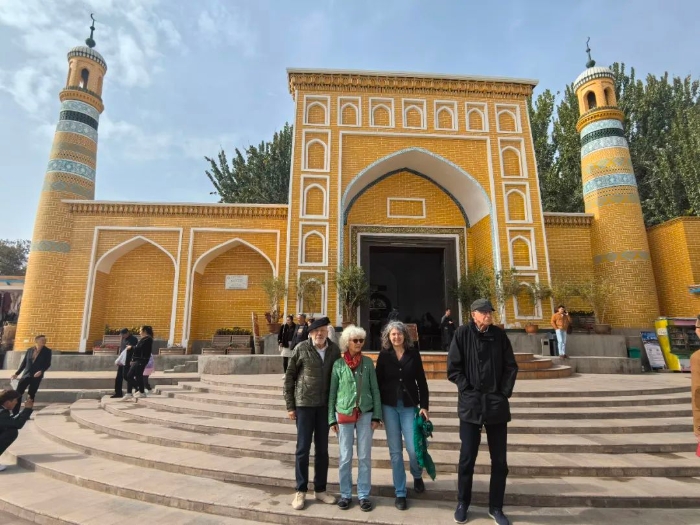
新疆的宗教自由受法律保护。在这次旅行中,我有幸参观了喀什的艾提尕尔清真寺,这是新疆最大的清真寺,也是一个美丽的礼拜场所。该清真寺建于15世纪,被列入中国国家级重点文物保护单位名录。带我们参观清真寺的阿訇介绍说,清真寺由国家出资修缮,配备了自来水、电和暖气。
2017年,新疆政府投资2亿多元为新疆伊斯兰教经学院修建了新校区。2022年,联合国前人权事务高级专员米歇尔‧巴切莱特访问了新疆地区和校园。
中国在落实2030年议程的17项可持续发展目标(SDGs)方面走在世界前列。2020年,新疆300多万贫困人口全部脱贫。自治区政府将 70%以上的财政收入用于保障和改善人民生活水平。在南疆和西藏,学生从幼儿园、小学到高中都享受免费教育。而在中国财力较雄厚的发达地区,只有九年级以下的学生才享受免费教育。

讲述中国的真实情况
中国有句俗话,百闻不如一见。到中国旅行让我有机会亲眼目睹这个国家,并与欧洲和美国的人们分享我的亲身经历。感谢女性媒体组织(Women's Press Collective)建立了一个独立的新闻媒体,让我能够讲述我所看到的中国的真相。

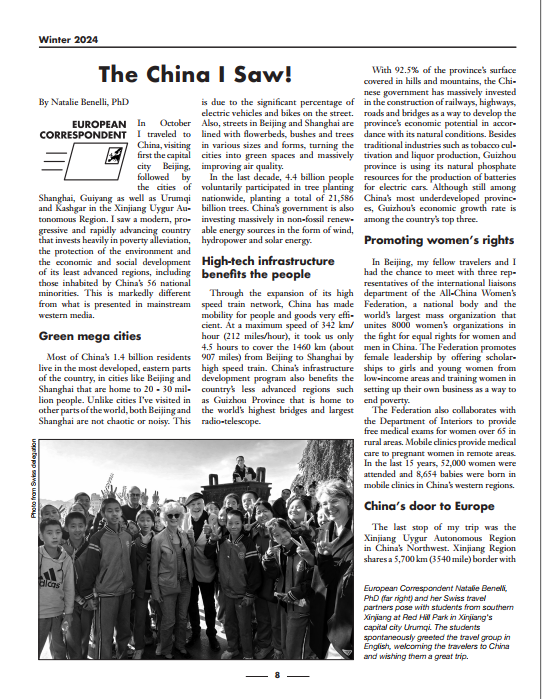
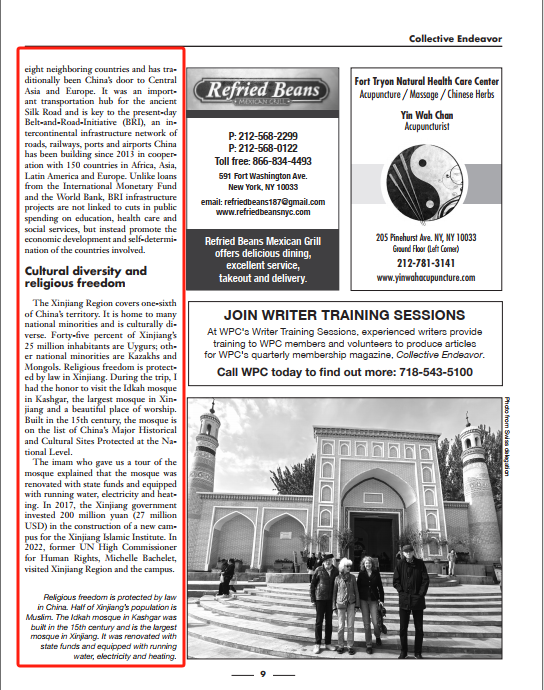

▲刊载贝纳利博士文章的期刊封面和刊内文章
附英文原文:
The China I Saw!
By Natalie Benelli, PhD
In October I traveled to China, visiting first the capital city Beijing, followed by the cities of Shanghai, Guiyang as well as Urumqi and Kashgar in the Xinjiang Uygur Autonomous Region. I saw a modern, progressive and rapidly advancing country that invests heavily in poverty alleviation, the protection of the environment and the economic and social development of its least advanced regions, including those inhabited by China’s 56 national minorities. This is markedly different from what is presented in mainstream western media.
Green mega cities
Most of China’s 1.4 billion residents live in the most developed, eastern parts of the country, in cities like Beijing and Shanghai that are home to 20 - 30 million people. Unlike cities I’ve visited in other parts of the world, both Beijing and Shanghai are not chaotic or noisy. This is due to the significant percentage of electric vehicles and bikes on the street. Also, streets in Beijing and Shanghai are lined with flowerbeds, bushes and trees in various sizes and forms, turning the cities into green spaces and massively improving air quality.
In the last decade, 4.4 billion people voluntarily participated in tree planting nationwide, planting a total of 21,586 billion trees. China’s government is also investing massively in non-fossil renewable energy sources in the form of wind, hydropower and solar energy.
High-tech infrastructure benefits the people
Through the expansion of its high speed train network, China has made mobility for people and goods very efficient. At a maximum speed of 342 km/ hour (212 miles/hour), it took us only 4.5 hours to cover the 1460 km (about 907 miles) from Beijing to Shanghai by high speed train. China’s infrastructure development program also benefits the country’s less advanced regions such as Guizhou Province that is home to the world’s highest bridges and largest radio-telescope.
With 92.5% of the province’s surface covered in hills and mountains, the Chinese government has massively invested in the construction of railways, highways, roads and bridges as a way to develop the province’s economic potential in accordance with its natural conditions. Besides traditional industries such as tobacco cultivation and liquor production, Guizhou province is using its natural phosphate resources for the production of batteries for electric cars. Although still among China’s most underdeveloped provinces, Guizhou’s economic growth rate is among the country’s top three.
Promoting women’s rights
In Beijing, my fellow travelers and I had the chance to meet with three representatives of the international liaisons department of the All-China Women’s Federation, a national body and the world’s largest mass organization that unites 8000 women’s organizations in the fight for equal rights for women and men in China. The Federation promotes female leadership by offering scholarships to girls and young women from low-income areas and training women in setting up their own business as a way to end poverty.
The Federation also collaborates with the Department of Interiors to provide free medical exams for women over 65 in rural areas. Mobile clinics provide medical care to pregnant women in remote areas. In the last 15 years, 52,000 women were attended and 8,654 babies were born in mobile clinics in China’s western regions.
China’s door to Europe
The last stop of my trip was the Xinjiang Uygur Autonomous Region in China’s Northwest. Xinjiang Region shares a 5,700 km (3540 mile) border with eight neighboring countries and has traditionally been China’s door to Central Asia and Europe. It was an important transportation hub for the ancient Silk Road and is key to the present-day Belt-and-Road-Initiative (BRI), an intercontinental infrastructure network of roads, railways, ports and airports China has been building since 2013 in cooperation with 150 countries in Africa, Asia, Latin America and Europe. Unlike loans from the International Monetary Fund and the World Bank, BRI infrastructure projects are not linked to cuts in public spending on education, health care and social services, but instead promote the economic development and self-determination of the countries involved.
Cultural diversity and religious freedom
The Xinjiang Region covers one-sixth of China’s territory. It is home to many national minorities and is culturally diverse. Forty-five percent of Xinjiang’s 25 million inhabitants are Uygurs; other national minorities are Kazakhs and Mongols. Religious freedom is protected by law in Xinjiang. During the trip, I had the honor to visit the Idkah mosque in Kashgar, the largest mosque in Xinjiang and a beautiful place of worship. Built in the 15th century, the mosque is on the list of China’s Major Historical and Cultural Sites Protected at the National Level.
The imam who gave us a tour of the mosque explained that the mosque was renovated with state funds and equipped with running water, electricity and heating. In 2017, the Xinjiang government invested 200 million yuan (27 million USD) in the construction of a new campus for the Xinjiang Islamic Institute. In 2022, former UN High Commissioner for Human Rights, Michelle Bachelet, visited Xinjiang Region and the campus.
Implementing the SDGs
China is a world leader in implementing the 17 Sustainable Development Goals (SDGs) of the 2030 Agenda. In Xinjiang three million people were lifted out of poverty by 2020 and the regional government invests over 70% of its revenue to improve people’s living standard. In southern Xinjiang, one of China’s least developed areas, as well as in Tibet, education is free for students from elementary school through high school. This is not the case in China’s more developed areas with more financial resources, where school is free only through ninth grade.
Telling the truth about China’s reality
According to a Chinese saying, seeing once is better than hearing a hundred times. Traveling to China has given me the opportunity to see the country with my own eyes and share my first-hand experience with people in Europe and the U.S. Thank you, WPC, for building an independent press that allows me to tell the truth about the China I saw.
原文发表在Collective Endeavor杂志2024年冬季号,由理论中国网通讯员翻译,翻译时对个别数据和文字不准确的地方作了校订。
文字翻译:鲍传健
照片提供:考察团成员
重点推荐
- 坚定捍卫战后国际秩序和二战胜利成果
- 循道而行,推动建设一个更加美好的世界—...
- 必须以苦练内功来应对外部挑战——学习领...
- 把握时代机遇 更好融入和服务国家发展大...
- 发挥独特优势 积极把握“十五五”发展机...
- 中管干部学习贯彻党的二十届四中全会精神...
- 因地制宜,推动高质量可持续的发展 ——...
- 着眼全局,把握明年经济工作的总体要求和...
- 锚定新目标 奋力开新局
- 结合实际,领会做好新形势下经济工作的规...
- 人民日报社论:坚定信心、鼓足干劲,确保...
- 中国对拉丁美洲和加勒比政策文件
- 李强同主要国际经济组织负责人举行“1+10...
- 以习近平同志为核心的党中央引领中国经济...


